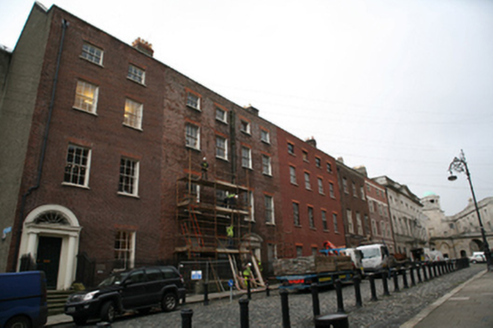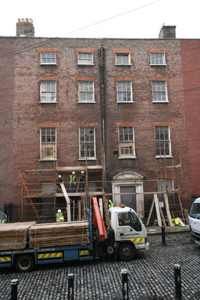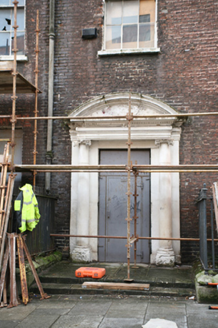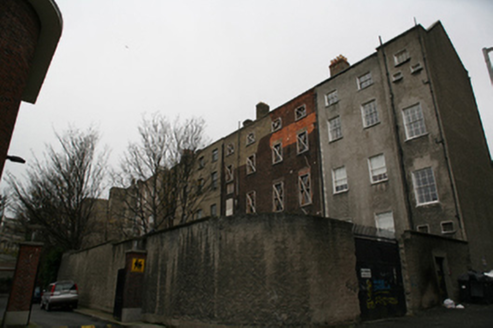Survey Data
Reg No
50010675
Rating
Regional
Categories of Special Interest
Architectural, Artistic
Original Use
House
Date
1745 - 1755
Coordinates
315238, 234943
Date Recorded
08/12/2011
Date Updated
--/--/--
Description
Terraced four-bay four-storey house over exposed basement, built c.1750, currently being restored by Dublin City Council. M-profile slate roof with central pitched section to central valley. Roof hidden behind parapet wall with granite coping and cast-iron hopper and downpipe breaking through to centre. Brown brick chimneystacks to both party walls with brick coping and clay pots. Red brick walls laid in Flemish bond with partially intact lime tuck-pointing and wigging. Chamfered granite plinth course over rubble stone basement walls. Brown brick walls to rear elevation with yellow brick and later red brick repaired sections to upper floors. Replacement gauged red brick flat-arch window openings with patent rendered reveals, masonry sills and replacement timber sliding sash windows throughout, six-over-six pane to first and second floors and three-over-three pane to western two bays of top floor. Square-headed door opening with painted stone pedimented Ionic doorcase. Steel security door with plain masonry surround flanked by Ionic columns on plinth blocks supporting full entablature with pulvinated frieze and dentillated segmental pediment having responding mouldings to either side. Door opens onto granite platform and two granite steps bridging basement. Platform and basement enclosed by wrought-iron railings with cast-iron finials to corner posts set on moulded granite plinth wall with matching iron gate to east.
Appraisal
This house stands in Henrietta Street, a cul-de-sac laid out by Luke Gardiner in the 1720s and containing the finest early Georgian houses in the city. Named after Henrietta Crofts, the third wife of Charles Paulet, 2nd Duke of Bolton and Lord Lieutenant in 1717-21, the street developed in a piecemeal fashion and set the trends of scale and design in domestic architecture. This building was leased by Luke Gardiner to Viscount Molesworth in 1755 and the interior is reputed to have been much altered in the 1790s. The house was recently stabilised by Dublin City Council in the early phase of a comprehensive programme of conservation works. The interior retains some good plasterwork but has lost its principal staircase and forms part of what has been described as 'Dublin’s Street of Palaces' while the ongoing conservation work will no doubt contribute to the improving fortunes of this remarkable streetscape. The fine pedimented doorcase is the decorative focus of the facade.







